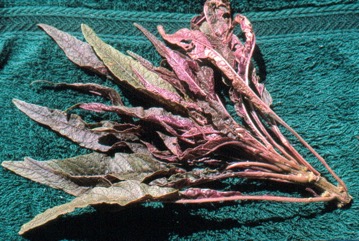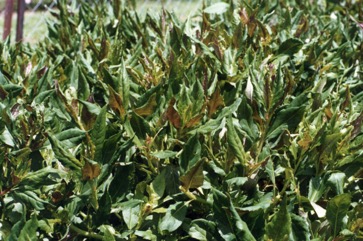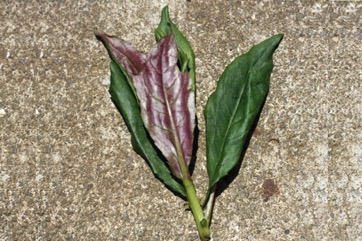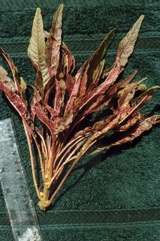Perilla, Beefsteak plant

A tropical plant. Plants are frost tender. In Nepal they grow between 600-2400 m altitude. It needs rich, well-drained soil and full sun. It suits hardiness zone 8-11. In XTBG Yunnan. In Sichuan.
Also known as:
Angami, Arim, Bai-su-zi, Ban tulsi, Bhangiro, Bhanjira, Che-so, Chiso, Deulkkae, Egoma, Gee so, Jen, Jhutela, Kenia, Kkaennip, Naga machala, Namdung, Ngaa khee mon, Perille verte cultivee, Ri ben bai su, Seelam, Shan-hnan, Shiso, Silam, Silame, Sipui, Snem, Sookloti, Tanam, Thi, Tia To, Zhou bai su, Zi su
Synonyms
- Perilla nankingensis Decne
- Perilla arguta Benth.
- Perilla crispa
- Ocimum frutescens Linnaeus
- Melissa cretica Loureiro
- Melissa maxima Arduino
- Mentha perilloides Lamarck
- Perilla avium Dunn
- Perilla ocymoides Linnaeus
- Perilla urticaefolia Salisbury
Edible Portion
- Leaves, Seeds - spice, Flowers, Seeds - oil, Vegetable, Leaves - tea
Where does Perilla grow?
Found in: Asia, Australia, Bhutan, Cambodia, China, SE Asia, Europe, Hawaii, Himalayas, India, Indochina, Indonesia, Japan, Korea, Laos, Malaysia, Myanmar, Nepal, North America, Northeastern India, Pacific, Pakistan, Papua New Guinea, PNG, Russia, SE Asia, Sikkim, Taiwan, Tasmania, Tibet, United States, Vietnam
Notes: There is only one (6) Perilla species.
Status: It is a commercially cultivated vegetable. It is sold in local markets in China.
Growing Perilla, Beefsteak plant
Cultivation: Plants are grown from seed. The seed need to be cooled to 5°C for 3 days before planting. Seed need light to germinate. Plants should be spaced about 30 cm apart.
Edible Uses: The young leaves, flowers and seeds are eaten cooked. They can be dried and used later. They are also used for flavouring. They are used in chutney. The young cotyledons are sprouted and eaten. The roasted seeds are pickled. The seed oil is used as an ingredient in cooking. They are used to improve the taste of curry. Caution: Wild forms are poisonous due to ketones. These are toxins to the liver.
Nutrition Info
per 100g edible portion| Edible Part | Energy (kcal) | Protein (g) | Iron (mg) | Vitamin A (ug) | Vitamin c (mg) | Zinc (mg) | % Water |
|---|---|---|---|---|---|---|---|
| Leaves | 42 | 3.4 | 6.7 | - | - | - | 86 |
| Seeds | 42 | 2.6 | 1.3 | - | - | - | 88.2 |
Perilla, Beefsteak plant Photos




References
Perilla references Perilla frutescens
Altschul, S.V.R., 1973, Drugs and Foods from Little-known Plants. Notes in Harvard University Herbaria. Harvard Univ. Press. Massachusetts. no. 3921
Ambasta, S.P. (Ed.), 2000, The Useful Plants of India. CSIR India. p 440
Arora, R. K., 2014, Diversity in Underutilized Plant Species - An Asia-Pacific Perspective. Bioversity International. p 43, 107 (Also as Perilla arguta)
Aryal, K. P., et al, 2018, Diversity and use of wild and non-cultivated edible plants in the Western Himalaya. Journal of Ethnobiology and Ethnomedicine (2018) 14:10
Barua, U., et al, 2007, Wild edible plants of Majuli island and Darrang districts of Assam. Indian Journal of Traditional Knowledge 6(1) pp 191-194
Brickell, C. (Ed.), 1999, The Royal Horticultural Society A-Z Encyclopedia of Garden Plants. Convent Garden Books. p 772
Burkill, I.H., 1966, A Dictionary of the Economic Products of the Malay Peninsula. Ministry of Agriculture and Cooperatives, Kuala Lumpur, Malaysia. Vol 2 (I-Z) p 1723 (As Perilla nankinensis and also Perilla ocimoides Linn.)
Cheifetz, A., (ed), 1999, 500 popular vegetables, herbs, fruits and nuts for Australian Gardeners. Random House p 146
Creasy, R., 2000, The Edible Asian Garden. Periplus p 52
Cundall, P., (ed.), 2004, Gardening Australia: flora: the gardener's bible. ABC Books. p 1011
Dangol, D. R. et al, 2017, Wild Edible Plants in Nepal. Proceedings of 2nd National Workshop on CUAOGR, 2017.
Dobriyal, M. J. R. & Dobriyal, R., 2014, Non Wood Forest Produce an Option for Ethnic Food and Nutritional Security in India. Int. J. of Usuf. Mngt. 15(1):17-37
Duke, J.A., 1992, Handbook of Edible Weeds. CRC Press. p 142
Facciola, S., 1998, Cornucopia 2: a Source Book of Edible Plants. Kampong Publications, p 132
Flora of Pakistan. www.eFloras.org
Food Composition Tables for use in East Asia FAO http://www.fao.org/infoods/directory No. 332 (As Peria frutescens)
Gouldstone, S., 1983, Growing your own Food-bearing Plants in Australia. Macmillan p 193
Hibbert, M., 2002, The Aussie Plant Finder 2002, Florilegium. p 229
Illustrated Flora of Central Texas p 768
Kays, S. J., and Dias, J. C. S., 1995, Common Names of Commercially Cultivated Vegetables of the World in 15 languages. Economic Botany, Vol. 49, No. 2, pp. 115-152
Khanal, R., et al, 2014, Documenting abundance and use of underutilized plant species in the mid hill region of Nepal. ECOPRINT 21: 63-71, 2014
Kiple, K.F. & Ornelas, K.C., (eds), 2000, The Cambridge World History of Food. CUP p 1730, 1833
Larkcom, J., 1991, Oriental Vegetables, John Murray, London, p 108, 137
Lawton, B.P., 2002, Mints. A Family of Herbs and Ornamentals. Timber Press, Portland, Oregon. p 168
Li, D. et al, 2017, Ethnobotanical survey of herbal tea plants from the traditional markets in Chaoshan, China. Journal of Ethnopharmacology. 205 (2017) 195-206
Li Hai-wen, Hedge, I.C., Lamiaceae. Flora of China. p 319
Liu, Yi-tao, & Long, Chun-Lin, 2002, Studies on Edible Flowers Consumed by Ethnic Groups in Yunnan. Acta Botanica Yunnanica. 24(1):41-56
Manandhar, N.P., 2002, Plants and People of Nepal. Timber Press. Portland, Oregon. p 351
Martin, F.W. & Ruberte, R.M., 1979, Edible Leaves of the Tropics. Antillian College Press, Mayaguez, Puerto Rico. p 196
Medhi, P. & Borthakur, S. K., 2012, Phytoresources from North Cachur Hills of Assam -3: Edible plants sold at Hflong market. Indian Journal of Natural Products and Resources. 3(1) pp 84-109
Mem. Torrey Bot. Club 5:277. 1894
Murtem, G. & Chaudhrey, P., 2016, An ethnobotanical note on wild edible plants of Upper Eastern Himalaya, India. Brazilian Journal of Biological Sciences, 2016, v. 3, no. 5, p. 63-81
Myuki, N., Lee, J. K., and Ohnishi, O., 2003, Asian Perilla Crops and Their Weedy Forms: Their Cultivation, Utilization and Genetic Relationships. Economic Botany 57(2): 245-253
Nabeta, K., and H.Sugisawa, 1983, Volatile components produced by callus tissues from the Perilla plants. Pages 65-84 in G.Charalambous and G. Inglett, eds., Instrumental analysis of foods. Vol.1 Academic Press, New York.
Okazaki, N., M.Matsunaka, M.Kondo, and K.Okamoto, 1982, Contact dermatitis due to beefsteak plant. (Perilla frutescens Britton var. acuta Kudoa). Skin Res. 24:250-256.
Patiri, B. & Borah, A., 2007, Wild Edible Plants of Assam. Geethaki Publishers. p 104
Plants for a Future database, The Field, Penpol, Lostwithiel, Cornwall, PL22 0NG, UK. http://www.scs.leeds.ac.uk/pfaf/
Raghavan, S., 2007, Handbook of Spices, Seasonings, and Flavourings. Second Edition. CRC Press p 70
Saikia, M., 2015, Wild edible vegetables consumed by Assamese people of Dhemaji District of Assam, NE India and their medicinal values. Archives of Applied Science Research, 2015, 7 (5):102-109 (As Perilla ocymoides)
Sarma, H., et al, 2010, Updated Estimates of Wild Edible and Threatened Plants of Assam: A Meta-analysis. International Journal of Botany 6(4): 414-423
Savita, et al, 2006, Studies on wild edible plants of ethnic people in east Sikkim. Asian J. of Bio Sci. (2006) Vol. 1 No. 2 : 117-125 (As Perilla ocymoides)
Schneider, E., 2001, Vegetables from Amaranth to Zucchini: The essential reference. HarperCollins. p 486
Self, M., 199, Phoenix Seeds catalogue. p 7
Singh, H.B., Arora R.K.,1978, Wild edible Plants of India. Indian Council of Agricultural Research, New Delhi. p 32
Smith, K., 1998. Growing Uncommon Fruits and Vegetables. New Holland. p 53
Solomon, C., 2001, Encyclopedia of Asian Food. New Holland. p 279
Song, M., et al, 2013, Traditional knowledge of wild edible plants in Jeju Island, Korea. Indian Journal of Traditional Knowledge. 12(2) pp 177-194 (As var. japonica)
Srivastava, R. C., 2009, Traditional knowledge of Adi tribe of Arunachal Pradesh on plants. Indian Journal of Traditional Knowledge. 8(2): 146-153 (As Perilla ocymoides)
Staples, G.W. and Herbst, D.R., 2005, A tropical Garden Flora. Bishop Museum Press, Honolulu, Hawaii. p 360
Taram, M., et al, 2018, Wild Food Plant Resources of Komkar Adi Tribe of Upper Siang District in Arunachal Pradesh, India. Bulletin of Arunachal Forest Research, Vol. 33(2), 27-35
Terra, G.J.A., 1973, Tropical Vegetables. Communication 54e Royal Tropical Institute, Amsterdam, p 65
Thomson, G. & Morgan, W., (Ed.) 2000, Access to Asian Foods Newsletter, Vic Govt., Australia Issue 30; 2001, Issue 38
Uprety, Y., et al, 2012, Diversity of use and local knowledge of wild edible plant resources in Nepal. Journal of Ethnobotany and Ethnomedicine 8:16
Van Sam, H. et al, 2008, Uses and Conservation of Plant Species in a National Park. A case study of Ben En, Vietnam. Economic Botany 62:574-593
van Wyk, B., 2005, Food Plants of the World. An illustrated guide. Timber press. p 284
Wang, J. et al, 2013, A Study on the Utilization of Wild Plants for Food in Liangshan Yi Autonomous Prefecture. Plant Diversity and Resources. 35(4): 416-471
Wilson, B.J., J.E. Garst , R.D. Linnabary, and R.B. Channell. 1977. Perilla ketone: a potent lung toxin from the mint plant, Perilla frutescens Britton. Science 197:573-574
Woodward, P., 2000, Asian Herbs and Vegetables. Hyland House. p 108
World Checklist of Useful Plant Species 2020. Royal Botanic Gardens, Kew